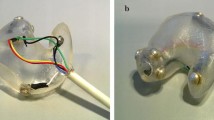Abstract
A software framework is described which was designed to process EEG, video of one eye, and head movement in real time, towards achieving early detection of microsleeps for prevention of fatal accidents, particularly in transport sectors. The framework is based around a pipeline structure with user-replaceable signal processing modules. This structure can encapsulate a wide variety of feature extraction and classification techniques and can be applied to detecting a variety of aspects of cognitive state. Users of the framework can implement signal processing plugins in C++ or Python. The framework also provides a graphical user interface and the ability to save and load data to and from arbitrary file formats. Two small studies are reported which demonstrate the capabilities of the framework in typical applications: monitoring eye closure and detecting simulated microsleeps. While specifically designed for microsleep detection/prediction, the software framework can be just as appropriately applied to (i) other measures of cognitive state and (ii) development of biomedical instruments for multi-modal real-time physiological monitoring and event detection in intensive care, anaesthesiology, cardiology, neurosurgery, etc. The software framework has been made freely available for researchers to use and modify under an open source licence.








Similar content being viewed by others
References
Borghini G, Astolfi L, Vecchiato G, Mattia D, Babiloni F (2014) Measuring neurophysiological signals in aircraft pilots and car drivers for the assessment of mental workload, fatigue and drowsiness. Neurosci Biobehav Rev 44:58–75. doi:10.1016/j.neubiorev.2012.10.003
Zander TO, Kothe C (2011) Towards passive brain–computer interfaces: applying brain–computer interface technology to human–machine systems in general. J Neural Eng 8:25005. doi:10.1088/1741-2560/8/2/025005
Reeves LM, Schmorrow DD, Stanney KM (2007) Augmented cognition and cognitive state assessment technology – near-term, mid-term, and long-term research objectives. In: Foundations of augmented cognition. Springer, Berlin, pp. 220–228. doi:10.1007/978-3-540-73216-7_25
Jones RD, Poudel GR, Innes CRH, Davidson PR, Peiris MTR, Malla AM, Signal TL, Carroll GJ, Watts R, Bones PJ (2010) Lapses of responsiveness: characteristics, detection, and underlying mechanisms. In: Proceedings of 32nd IEEE Conference on Engineering in Medicine and Biology Society. pp 1788–1791. doi:10.1109/IEMBS.2010.5626385
Davidson PR, Jones RD, Peiris MTR (2007) EEG-based lapse detection with high temporal resolution. IEEE Trans Biomed Eng 54:832–839. doi:10.1109/TBME.2007.893452
Peiris MTR, Davidson PR, Bones PJ, Jones RD (2011) Detection of lapses in responsiveness from the EEG. J Neural Eng 8:16003. doi:10.1088/1741-2560/8/1/016003
Golz M, Sommer D, Chen M, Trutschel U, Mandic D (2007) Feature fusion for the detection of microsleep events. J VLSI Signal Process 49:329–342. doi:10.1007/s11265-007-0083-4
Knopp SJ (2015) A multi-modal device for application in microsleep detection. PhD thesis, University of Canterbury. http://hdl.handle.net/10092/10408. Accessed 04 Oct 2015
da Silva HP, Lourenço A, Fred A, Martins R (2014) BIT: biosignal igniter toolkit. Comput Methods Progr Biomed 115:20–32. doi:10.1016/j.cmpb.2014.03.002
BITalino DIY biosignals. http://bitalino.com/. Accessed 04 Oct 2015
Lourenço A, da Silva HP, Carreiras C, Alves AP, Fred A (2014) A web-based platform for biosignal visualization and annotation. Multimed Tools Appl 70:433–460. doi:10.1007/s11042-013-1397-9
Heger D, Putze F, Amma C, Wand M, Plotkin I, Wielatt T, Schultz T (2010) BiosignalsStudio: a flexible framework for biosignal capturing and processing. In: Dillmann R, Beyerer J, Hanebeck UD, Schultz T (eds) Annual conference on artificial intelligence. Springer, Berlin/Heidelberg, pp 33–39. doi:10.1007/978-3-642-16111-7_3
Guger Technologies. http://www.gtec.at/Products/. Accessed 04 Oct 2015
GStreamer: open-source multimedia framework. http://gstreamer.freedesktop.org/. Accessed 04 Oct 2015
Qt. http://qt.io/. Accessed 04 Oct 2015
Gamma E, Helm R, Johnson R, Vlissides J (1994) Design patterns: elements of reusable object-oriented software. Pearson Education, Upper Saddle River
Pree W (1994) Meta patterns—a Means for capturing the essentials of reusable object-oriented design. In: Object-oriented program. Springer, Berlin, pp 150–162
Jones E, Oliphant T, Peterson P et al (2001) SciPy: open source scientific tools for Python. http://www.scipy.org/. Accessed 04 Oct 2015
Santamaria J, Chiappa KH (1987) The EEG of drowsiness in normal adults. J Clin Neurophysiol 4:327–382. doi:10.1097/00004691-198710000-00002
Knopp SJ, Bones PJ, Weddell SJ, Innes CRH, Jones RD (2013) A wearable device for measuring eye dynamics in real-world conditions. In: Proceedings of 35th IEEE Conference on Engineering in Medicine and Biology Society, pp 6615–6618. doi:10.1109/EMBC.2013.6611072
Wierwille WW, Ellsworth LA (1994) Evaluation of driver drowsiness by trained raters. Accid Anal Prev 26:571–581. doi:10.1016/0001-4575(94)90019-1
Boulton RJ, Walthinsen E, Baker S, Johnson L, Bultje RS, Kost S, Müller T-P, Taymans W (2015) GStreamer plugin writer’s guide, Ch 15: memory management. http://gstreamer.freedesktop.org/data/doc/gstreamer/head/pwg/html/chapter-allocation.html. Accessed 04 Oct 2015
Ayyagari SSDP, Jones RD, Weddell S (2015). Optimized echo state networks with leaky integrator neurons for EEG-based microsleep detection. In: Proceedings of 37th IEEE Conference on Engineering in Medicine and Biology Society, pp 3775–3778. doi:10.1109/EMBC.2015.7319215
Shoorangiz R, Weddell S, Jones RD (2016). Prediction of microsleeps from EEG: preliminary results. In: Proceedings of 38th IEEE Conference on Engineering in Medicine and Biology Society, pp 4650–4653
Acknowledgements
Simon Knopp was the recipient of a University of Canterbury Doctoral Scholarship and the work reported formed part of his doctoral study.
Author information
Authors and Affiliations
Corresponding author
Ethics declarations
Conflict of interest
The authors declare that they have no financial or personal relationships with other people or organisations that could have inappropriately influenced this work.
Ethical approval
Ethical approval was not required due to the small scale and non-invasive nature of the experiments.
Rights and permissions
About this article
Cite this article
Knopp, S.J., Bones, P.J., Weddell, S.J. et al. A software framework for real-time multi-modal detection of microsleeps. Australas Phys Eng Sci Med 40, 739–749 (2017). https://doi.org/10.1007/s13246-017-0559-x
Received:
Accepted:
Published:
Issue Date:
DOI: https://doi.org/10.1007/s13246-017-0559-x




